Not everything is perfect
A brain operation with an L3-3 tube tester.
The electric parts inside the L3-3 are of exceptional good quality. The cable tree has cotton isolation under the wires. Though the plastic is a normal one, so no Teflon or so, it is quite rugged and real shorts due to over current are very rare. This tester here had a short under the switch board, in the board itself. This was however not caused by components quality, but by a factory error in the cable tree.
This L3-3 tube tester could not test all rectifier tubes. Some yes, and at some others the mains fuse blew out. It was an NOS tester. In any case, something was overheated underneath the switchboard, and the spot where that happened was where the AC high voltage of the transformer is connected to the tube terminal bars. The terminal bars are physical bars indeed, and they go vertical along the switchboard. There is the bar for Anode-1 of the rectifier, and you need to plug a pin, to connect this bar with the right socket number. For Anode-2 the Grid-2 Bars is used, as there is no Anode-2 bar in fact, and rectifiers have no G2 anyway.
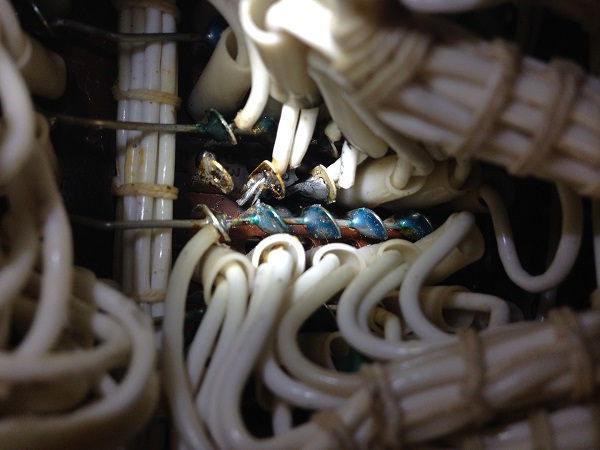 You can see the bars in the next picture. In the factory, all solder joints are painted blue, and it could be seen, somebody has been soldering there already. One wire have de soldered myself, the other two solder joints, as you can see, have no more blue paint on it. This shows the repair attempts of somebody else, and it is clear the person has given up on it, as the defect was not cured. Generally this means a lot of extra work. First, cleaning or checking the previous repair has to be done, and second, finding a short which blows the fuse is difficult to measure on. A very crude method is bypass the fuse with a piece of wire, and use a variac, to slowly ramp up the voltage. At some point something will begin to get hot, and that's where you have to start. Well, I am glad this crude method was not necessary.
You can see the bars in the next picture. In the factory, all solder joints are painted blue, and it could be seen, somebody has been soldering there already. One wire have de soldered myself, the other two solder joints, as you can see, have no more blue paint on it. This shows the repair attempts of somebody else, and it is clear the person has given up on it, as the defect was not cured. Generally this means a lot of extra work. First, cleaning or checking the previous repair has to be done, and second, finding a short which blows the fuse is difficult to measure on. A very crude method is bypass the fuse with a piece of wire, and use a variac, to slowly ramp up the voltage. At some point something will begin to get hot, and that's where you have to start. Well, I am glad this crude method was not necessary.
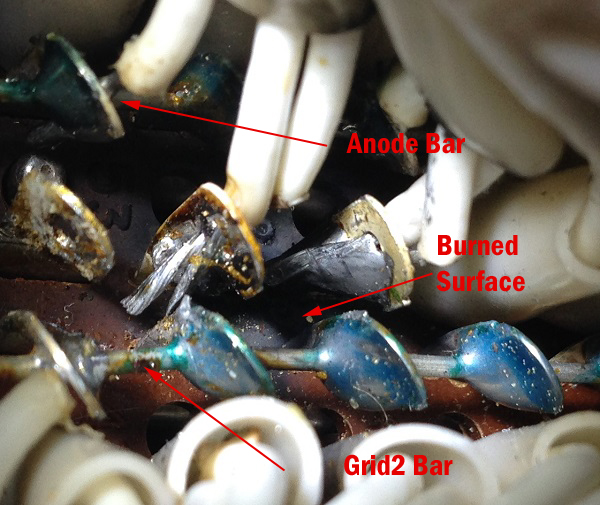 After removing the cables, the whole surface underneath was coal black burned. So no matter if these plugs and cables were the cause of the problem, this had to ne repaired first. In order to grind away (with a Drehmel) the coaled surface I needed to take the solder tags out, but that is easy to do actually. The burn damage was 1mm deep, and below came out nice and clean Bakelite. Also the solder tags itself had burn spots on it.
After removing the cables, the whole surface underneath was coal black burned. So no matter if these plugs and cables were the cause of the problem, this had to ne repaired first. In order to grind away (with a Drehmel) the coaled surface I needed to take the solder tags out, but that is easy to do actually. The burn damage was 1mm deep, and below came out nice and clean Bakelite. Also the solder tags itself had burn spots on it.
 These plugs were obviously a bit burned, but that doesn't have to mean they are the problem. It's just if there is a short, it will follow some path, and the devices in that path may LOOK like a possible problem maker, but most of the time they are not. So you keep on looking and looking, don't find it.
These plugs were obviously a bit burned, but that doesn't have to mean they are the problem. It's just if there is a short, it will follow some path, and the devices in that path may LOOK like a possible problem maker, but most of the time they are not. So you keep on looking and looking, don't find it.
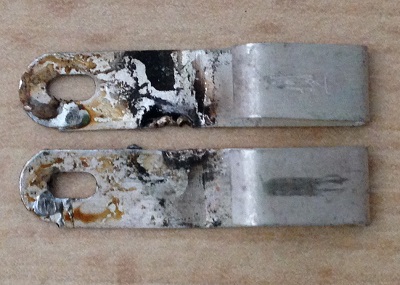 Yet the solder tags are relatively close together. I have picture them here, approximately at the position at which they are mounted in the switchboard. The distance between them is 1.6mm. Since there is 1100Volt AC (yes!) between them, when the 550V taps are used for rectifier testing, I don't have to explain here, that is not much distance. I found the tags are too big anyway, so it was easiest, just make them a little smaller.
Yet the solder tags are relatively close together. I have picture them here, approximately at the position at which they are mounted in the switchboard. The distance between them is 1.6mm. Since there is 1100Volt AC (yes!) between them, when the 550V taps are used for rectifier testing, I don't have to explain here, that is not much distance. I found the tags are too big anyway, so it was easiest, just make them a little smaller.
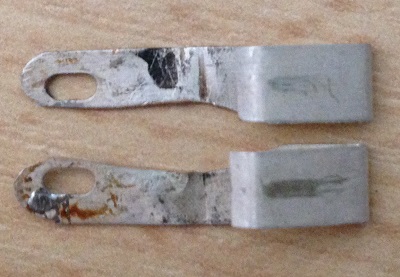 Now they look better, and air distance is appr 3mm like this. Inside the switchboard it is still 1.6mm, but that is isolated with Bakelite, or whatever material the switchboard is made of.
Now they look better, and air distance is appr 3mm like this. Inside the switchboard it is still 1.6mm, but that is isolated with Bakelite, or whatever material the switchboard is made of.
After putting everything back together, at least I was sure there is no short under the switchboard. gave it 50% chance the short was still there. And it was. So now I had to follow the wiring.
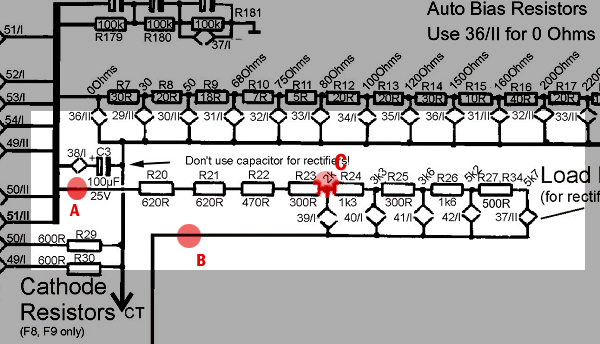 This is the rectifier load circuit. The reason for the short was the original factory wiring had a mistake in it. Where it says A and B, the cables were swapped. Interesting, because the resistors are all in series, that doesn't matter. Only there was another cable mounted on 'C' which did not belong there. This resulted in 'C' connected somewhere close to 'B'. Not directly on B itself, but close. This caused a short, which only works out when you have another load as the 2k plug. So some cards work, and some short the tester. Just by cutting off that false wire from plug 39/II, the short was gone. The swap of A to B could be left in, though a bit weird, this has no effect on anything, and otherwise I had to take the cable tree apart. So now the tester was repaired just by cutting out one wrong wire. It took 10 hours to find this crazy mistake, but it was fun to do.
This is the rectifier load circuit. The reason for the short was the original factory wiring had a mistake in it. Where it says A and B, the cables were swapped. Interesting, because the resistors are all in series, that doesn't matter. Only there was another cable mounted on 'C' which did not belong there. This resulted in 'C' connected somewhere close to 'B'. Not directly on B itself, but close. This caused a short, which only works out when you have another load as the 2k plug. So some cards work, and some short the tester. Just by cutting off that false wire from plug 39/II, the short was gone. The swap of A to B could be left in, though a bit weird, this has no effect on anything, and otherwise I had to take the cable tree apart. So now the tester was repaired just by cutting out one wrong wire. It took 10 hours to find this crazy mistake, but it was fun to do.
Visually the tester was certainly NOS, and it obviously left the factory that way. So I suppose they tested the rectifier part with a 5U4G, because that was a tube that worked normally.